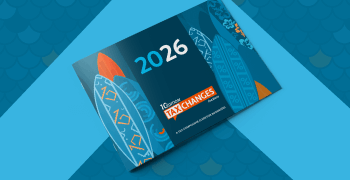
How to prepare your business for the 1099-K changes
The American Rescue Plan of 2021 changed the reporting threshold for Form 1099-K. Then the One Big Beautiful Bill Act of 2025 changed it back.
1099-K threshold FAQ
What is a 1099 form?
An IRS 1099 form is a tax form that documents payments to a business, individual, or entity that isn’t an actual employee. The payer is responsible for filling out the appropriate 1099 form and sending copies to the payee, the IRS, and where required, the state taxing authority.
There are different 1099 forms for different types of payments. Most forms must be sent to all necessary parties by January 31 of each year.
The Form 1099-K reports non-W-2 income received during the year from one of two types of reportable payment transactions:
Payment card transactions (credit, debit, or stored value cards such as gift cards)
Third-party network transactions (payment apps or online marketplaces, including third-party payment settlement organizations)
This includes payments for personal items sold, goods sold, services provided, or property rented through online marketplaces, auction sites, ticket exchange or resale sites, peer-to-peer payment platforms or digital wallets, and more.
Form 1099-K made headlines when the American Rescue Plan Act of 2021 significantly lowered its reporting requirements.
What happened to the 1099-K under the American Rescue Plan Act?
The American Rescue Plan (ARP) dramatically lowered the 1099-K reporting threshold for third-party settlement organizations.
Prior to the enactment of the ARP, online marketplaces, payment apps, and payment card companies were required to file a Form 1099-K with the IRS and provide a copy to any business, individual, or entity that earned over $20,000 in aggregate payments and had 200 such transactions in a calendar year. The ARP drastically cut that threshold to more than $600, period.
The 1099-K reporting threshold was scheduled to drop to $600 for tax year 2022, but in December 2022, the IRS delayed implementation of the 1099-K changes due to the magnitude and impact of the change.
In November 2023, the IRS said it would treat 2023 as an additional transition year to “reduce the potential confusion caused by the distribution of an estimated 44 million Forms 1099-K sent to many taxpayers who wouldn’t expect one and may not have a tax obligation.”
Then in December 2023, the IRS said it would phase in the $600 threshold because of “the complexity of the new provision and the large number of individual taxpayers affected.” The 1099-K threshold would be $5,000 for tax year 2024.
No further guidance was provided until November 26, 2024, when the IRS announced the cascading thresholds of $5,000 for 2024, $2,500 for 2025, and $600 for 2026 and beyond.
How did the One Big Beautiful Bill Act change Form 1099-K?
The One Big Beautiful Bill Act (OBBBA) returns the reporting threshold for Form 1099-K to $20,000 and 200 transactions. Per the legislation, this takes effect “as if included in section 9674 of the American Rescue Plan Act.”
Read One Big Beautiful Bill Act changes 1099 thresholds for more details.
How can companies streamline 1099 compliance?
Cloud-based automation solutions that scale with a business’s needs can help online marketplaces and third-party payment processors comply with the additional reporting requirements that will result from the lower 1099-K threshold.
Avalara 1099 & W-9 can help both businesses and accounting professionals streamline management of 1099-K forms. It allows you to store vendor and freelancer information, import 1099 payee data, and transfer vendor details for a quick turnaround, while automatically checking for errors.
This blog has been updated; it was originally published in December 2023.

Avalara Tax Changes 2026 is here
The 10th edition of our annual report engagingly breaks down key policies related to sales tax, tariffs, and VAT.
Stay up to date
Sign up for our free newsletter and stay up to date with the latest tax news.














